This article has been written in collaboration with Isla Mercer – Stonehaven (Scotland – UK)
When you think of Spain and Scotland, you might imagine two very different places — one with hot sun and flamenco dancing, the other with highland cows and bagpipes. But if you’re in Aberdeenshire and considering learning Spanish, you might be surprised at just how much these two cultures share! From fiery traditions to a love for the sea, let’s explore the fascinating similarities between Scotland and Spain.
Food is at the heart of both Scottish and Spanish culture. While Spanish cuisine, famous for the Mediterranean diet and tapas might feel far removed from hearty Scottish dishes, there are actually quite a few similarities these two countries share when it comes to food.
One common love? Seafood! Aberdeenshire’s coastal towns offer some of the best fish and shellfish in the UK, just as Spain boasts incredible seafood paellas and grilled octopus. Both Spain and Scotland also share a love for black pudding or as the Spanish would say, morcilla de Burgos. And Spain even has its very own version of porridge, gachas de almorta españolas.
No cultural comparison between Scotland and Spain would be complete without a mention of whisky! Some of Scotland’s finest whiskies are matured in sherry casks, with the sherry itself originating from the Jerez region of Spain. This means that one of Scotland’s most iconic exports owes part of its flavour profile to Spanish craftsmanship — showing just how deep the connection between Scotland and Spain is.
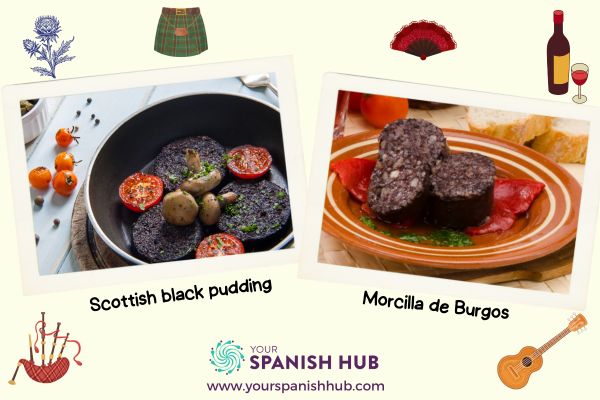
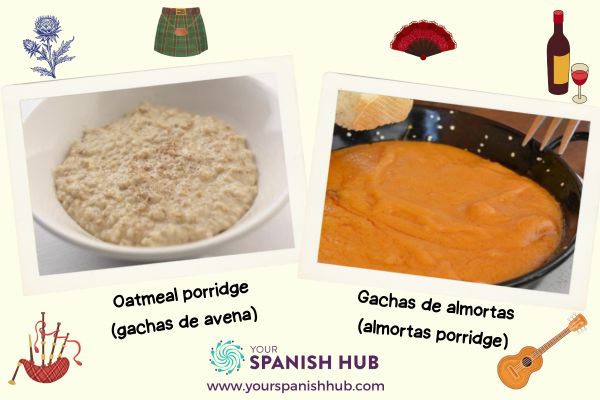
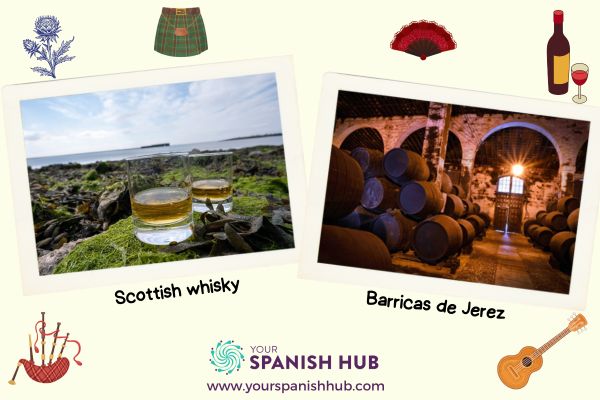
Both Aberdeenshire and Spain are home to fiery traditions. Stonehaven in Aberdeenshire plays host to the Fireballs spectacle at Hogmanay, where local people spin burning balls of fire around their heads in a procession along the harbour area of the town. In Valencia, there is a festival called Las Fallas where fireworks are set off and impressive sculptures are created and burned on the last night of celebrations in honor of Saint Joseph, the patron saint of carpenters.
Ceilidhs are a very important part of Scottish life, with primary school children even learning ceilidh dances as part of the school curriculum! Spain’s equivalent is sevillanas, which have their origins in the medieval songs called Castilian seguidillas. This type of music became very popular in Andalusia, particularly at the Seville Fair. With the influence of flamenco in southern Spain, the original Castilian seguidillas evolved into the current sevillanas.. At ceilidhs, male scots wear a kilt, which is a traditional tartan outfit worn at special events. Women at sevillanas would carry abanicos, or fans, high heels, earrings and shawl as part of the Spanish traditional flamenco dress.
Bagpipes are often one of the first things people think of when Scotland is mentioned and they are used to celebrate important occasions in Scottish culture. In Spain, guitars are often used and played in a distinctive Spanish style to provide atmosphere at events.
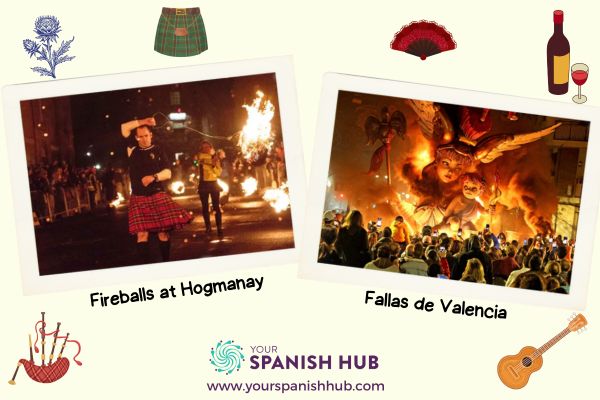
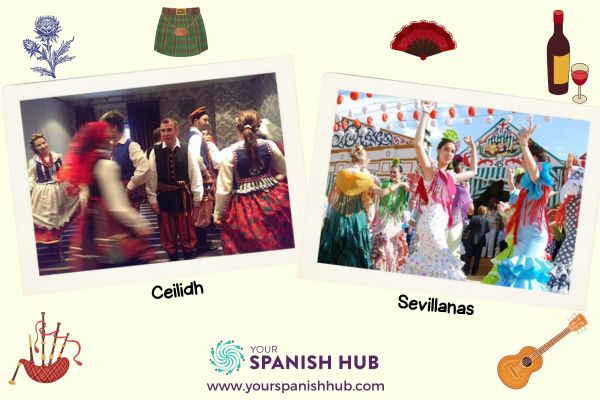
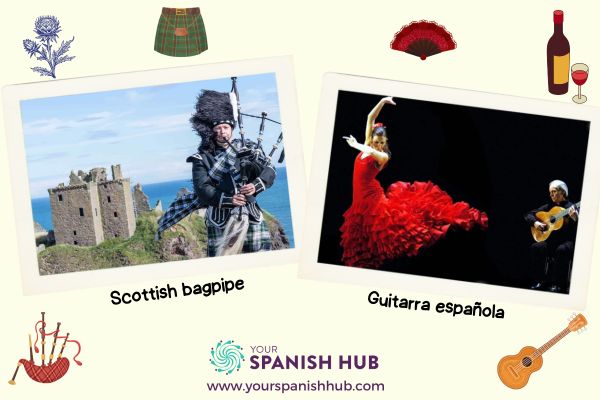
Both Scotland and Spain love sport, in particular, football, or fútbol as it is known in Spanish. Scotland is home to one of the oldest football leagues in the world and Spain boasts some of the biggest and best-known teams. Both countries are extremely patriotic and have a dedicated and passionate fan base.
And sometimes, they can even come together as one…
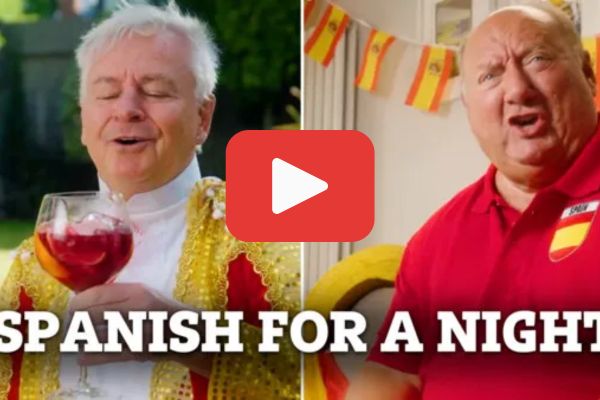
Just as Aberdeenshire has its own unique dialect—Doric—Spain is home to many regional languages and dialects, including Catalan, Galician, and Basque. Learning Spanish is a fantastic way to connect with Spain’s culture, just as understanding Doric helps people connect with Aberdeenshire’s rich history.
Here are some fun Doric phrases and their English and Spanish equivalents:
| DORIC | ENGLISH | SPANISH |
| Fit like? | How are you? | ¿Qué tal? |
| Foos yer doos? | How are you? | ¿Cómo estás? |
| Jist chavin’ awa | Just working away | Todo bien |
| Far ye gaan? | Where are you going? | ¿Dónde vas? |
| Far div ye bide? | Where do you live? | ¿Dónde vives? |
| Fa’s at? | Who is that? | ¿Quién es ese / esa? |
| Loons and quines | Boys and girls | Chicos y chicas |
| Puggled | Tired | Cansado / cansada |
| Bosie | Hug | Abrazo |
| A funcy piece | A cake/sweet treat | Un caprichito dulce |
| A fly cup | A cup of tea | Una taza de té |
Table by Isla Mercer
If you already speak Doric, you might find Spanish easier to learn than you think—both use a varied intonation and have a lot of similar sounds!
Learning Spanish isn’t just about holidays on the Costa del Sol. With over 500 million speakers worldwide, it can open up travel, job opportunities, and new friendships. Plus, if you already have an ear for Doric, you might find Spanish pronunciation easier than expected!
If you’re ready to embark on your Spanish journey, our online courses are designed to help learners in Aberdeenshire gain confidence in speaking, reading, and understanding Spanish. Whether you’re a complete beginner or looking to brush up your skills, our native speakers teachers? are on hand to help you become confident in conversational Spanish.
So why not give it a go? Or as they say in Spanish — ¿Por qué no intentarlo?
